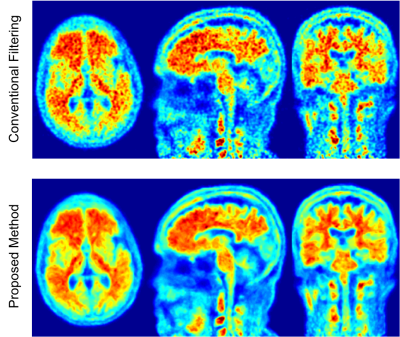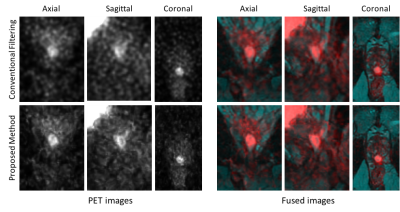Mehdi Khalighi1, Timothy Deller2, Kevin Chen1, Tyler Toueg3, Dawn Holley1, Kim Halbert1, Floris Jansen2, Elizabeth Mormino3, Michael Zeineh1, Farshad Moradi1, Greg Zaharchuk1, and Andrei Iagaru1
1Radiology, Stanford University, Stanford, CA, United States, 2Engineering Dept., GE Healthcare, Waukesha, WI, United States, 3Neurology, Stanford University, Stanford, CA, United States
1Radiology, Stanford University, Stanford, CA, United States, 2Engineering Dept., GE Healthcare, Waukesha, WI, United States, 3Neurology, Stanford University, Stanford, CA, United States
A new filtering method for PET images is proposed that exploits the correlation between voxels from the same tissue in addition to the correlation between neighboring voxels. Similar voxels within the PET volume are identified using KNN method in the feature-space built by anatomical priors.

Fig 3. Comparison of PET images with both conventional & proposed denoising methods. The images are reconstructed using TOF-OSEM with 1mm isotropic resolution. Top row images are filtered by a Gaussian filter with 4mm cut off freq. Bottom row images are filtered with the proposed method using anatomical priors. A neighborhood within 3 mm radius around each voxel was searched to find the 25 nearest neighbors. A Gaussian filter with 2mm spatial cut-off freq. was then applied to remove any remaining high freq. noise. The KNN and the Gaussian filter were applied 2 times iteratively.

Fig 4. Comparison of PET images with conventional and proposed denoising methods on a prostate cancer subject imaged with 5 mCi of PSMA. The PET images are reconstructed using TOF-OSEM with 1mm isotropic resolution. Top row images are filtered by a Gaussian filter with 4mm cut off freq. Bottom row images are filtered with the proposed method using anatomical priors. A neighborhood within 3 mm radius around each voxel was searched to find the 25 nearest neighbors of that voxel. A Gaussian filter with 2mm spatial cut-off frequency was then applied to remove any remaining high frequency noise.